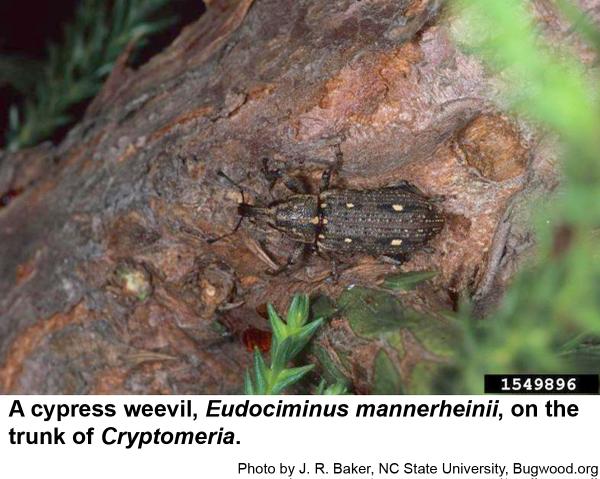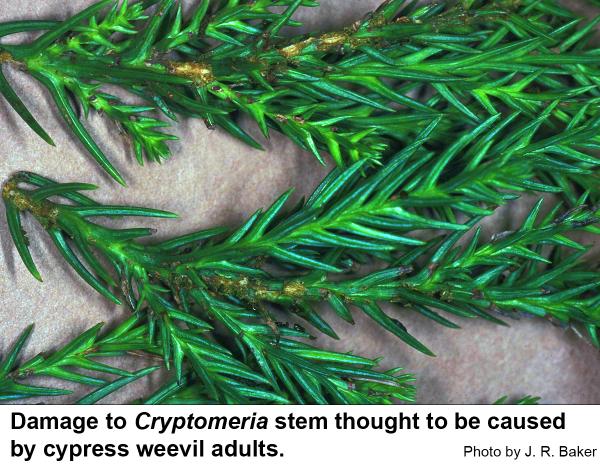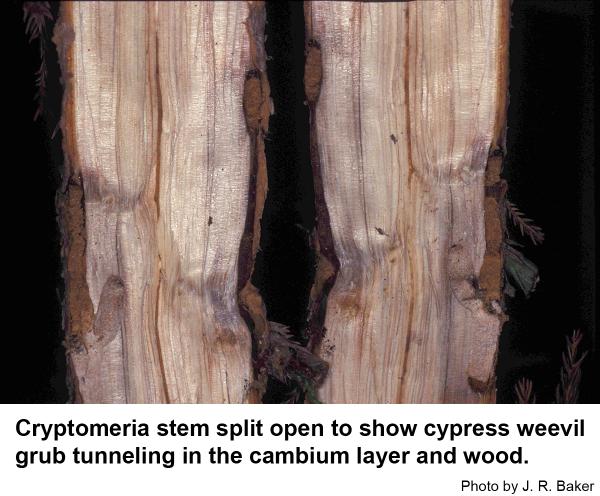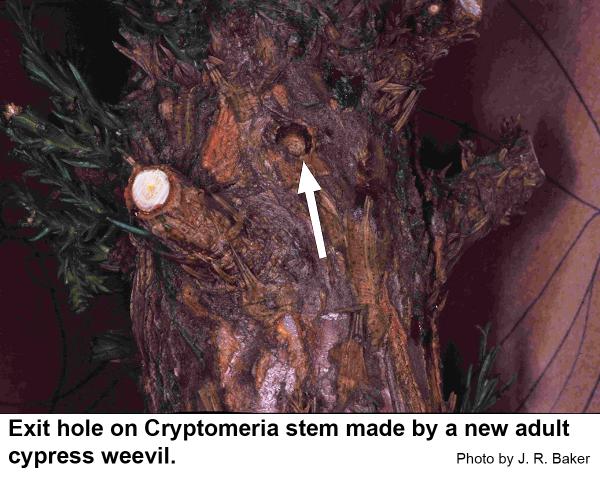General Information
Eudociminus mannerheimii was first described in 1836. It was next mentioned as the cypress weevil in 1904 by A.D. Hopkins who wrote that the adults kill the twigs of bald cypress (Taxodium) by feeding on them. The grubs bore under the bark and cause defects in the wood as the trees callous over the injury. The cypress weevil breeds readily in scarred and fallen cypress. In 1916, its known range extended from Louisiana to New York. Since New York is outside the range of bald cypress, the cypress weevil must have an alternative host (perhaps Atlantic white cedar). Except for lists in catalogs, we cannot find any publication on the cypress weevil since 1916. Until 1998, the only previous Eudociminus specimens in the North Carolina State University Insect Collection were two collected on September 1928 from Phelps Lake and two from White Lake collected on March 14, 1953. These were all associated with bald cypress. In the spring of 2004, we received specimens from Winston-Salem and the surrounding Triad area in Leyland cypress (XCupressocyparis leylandii). With the abundance of Leyland cypress in the landscape the last three decades, one should keep a watch out for future infestations. Since the 1970s, the cypress weevil, has infrequently been found damaging Cryptomeria, Leyland cypress, arborvitae and bald cypress in North Carolina. Adults feed on stems where the bark is still green but not in the needles. Larvae feed in the wood around the crown or base of the Leyland cypress and in the main stem of Cryptomeria and cypress.
Biology
Overwintered cypress weevil adults become active around mid-March in most locations in North Carolina. Since the 1970s, the cypress weevil has infrequently been found damaging Cryptomeria in commercial nurseries and landscapes in North Carolina. It is not certain whether the attacks on Cryptomeria are occasional outbreaks or if Eudociminus will have a major impact on Cryptomeria in the landscape. The cypress weevil is in the same group of weevils as the pales weevil, Hylobius pales, so it may have a similar life history. According to Insects of Eastern Forests, pales weevils overwinter as adults that may be active all winter (but in reproductive diapause) as adults in the forest litter or as larvae inside the host plant. This more or less agrees with what we have seen so far -– grubs are in the wood during the winter but some adults emerge almost immediately when the temperature warms. Adults feed on the stems where the bark is still green but not in the needles. Larvae were reported to feed in the wood around the crown or base of the Leyland cypress.
Control
Is the infestation treatable and worth the time and money? An infested plant may be so damaged that replacement is a better option than applying an insecticide. Since the adults feed on the bark, spraying the bark with a pyrethroid, such as permethrin, may protect against adult feeding and repel or kill them as they feed on the pesticide residue. Permethrin is labeled for borers in the landscape, and has a good residual life. In commercial nurseries Onyx (binfenthrin) or another pyrethroid product may be preferred. When used as directed, pyrethroids are very toxic to insects but are not particularly hazardous to humans and pets (other than fish-avoid using pyrethroids around pools, ponds, and streams). Though yet untested by us for cypress weevil suppression, Safari (dinotefuran) is labeled and would be expected to work. Acelepryn (chlorantraniliprolez) is a systemic with good activity against weevils and is labeled for soil drench on trees in the landscape. For cypress weevil control, it would be good to prune and destroy any dead wood, cull and destroy any plants that are beyond help, and then consider spraying the shrubs to prevent further feeding. We assume that the shrubs should be sprayed in March, early to mid-May and again in late June to early July. These dates are uncertain and may depend on which region of the state the infestation occurs.
Other Resources
- A Distributional Checklist of the Beetles (Coleoptera) of Florida. Arthropods of Florida and Neighboring Land Areas, Vol. 16. Peck SB, Thomas MC. 1998. Florida Department of Agriculture and Consumer Services, Division of Plant Industry, Gainesville. 180 p.
- Blatchley WS, Leng CW. 1916. Rhynchophora or Weevils of North Eastern America. The Nature Publishing Company, Indianapolis. 682 p.
- Catalogue of exhibits of insect enemies of forests and forest products at the Louisiana Purchase Exposition, St. Louis, MO. Hopkins AD. 1904. USDA Division of Entomology Bulletin No. 48. 56 p.
- Common name: cypress weevil, scientific name: Eudociminus mannerheimii (Boheman) (Coleoptera: Curculionidae). Mayfield III, A. E. 2005. Featured Creature, Division of Forestry, Florida Department of Agriculture and Consumer Services (FDACS). Publication EENY-360
- Insects of Eastern Forests. Drooz, A. T. 1985. USDA Forest Service Misc. Pub. 1426
- O'Brien CW, Wibmer GJ. 1982. Annotated Checklist of the Weevils (Curculionidae sensu lato) of North America, Central America, and the West Indies (Coleoptera: Curculionoidea). Memoirs of the American Entomological Institute, No. 34. 382 p.
- NC State Extension Plant Pathology Publications and Factsheets
- NC State Horticultural Science Publications
- North Carolina Agricultural Chemicals Manual
For assistance with a specific problem, contact your local N.C. Cooperative Extension center.
Publication date: March 1, 2004
Reviewed/Revised: Sept. 18, 2019
N.C. Cooperative Extension prohibits discrimination and harassment regardless of age, color, disability, family and marital status, gender identity, national origin, political beliefs, race, religion, sex (including pregnancy), sexual orientation and veteran status.





